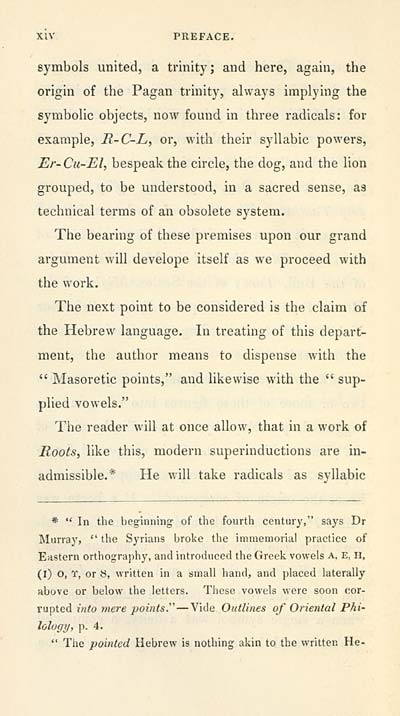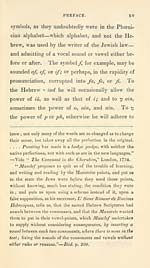Download files
Complete book:
Individual page:
Thumbnail gallery: Grid view | List view

symbols united, a trinity; and here, again, the
origin of the Pagan trinity, always implying the
symbolic objects, now found in three radicals: for
example, R-C-L, or, with their syllabic powers,
Er-Cu-El, bespeak the circle, the dog, and the lion
grouped, to be understood, in a sacred sense, as
technical terms of an obsolete system.
The bearing of these premises upon our grand
argument will develope itself as we proceed with
the work.
The next point to be considered is the claim of
the Hebrew language. In treating of this depart-
ment, the author means to dispense with the
" Masoretic points," and likewise with the " sup-
plied vowels."
The reader will at once allow, that in a work of
Roots, like this, modern superinductions are in-
admissible.* He will take radicals as syllabic
* " In the beginning of the fourth century," says Dr
Murray, " the Syrians broke the immemorial practice of
Eastern orthography, and introduced the Greek vowels A. E, H,
(I) O, T, or 8, written in a small hand, and placed laterally
above or below the letters. These vowels were soon cor-
rupted into mere points^ — Vide Outlines of Oriental Phi-
lology, p. 4.
" The pointed Hebrew is nothing akin to the written He-
origin of the Pagan trinity, always implying the
symbolic objects, now found in three radicals: for
example, R-C-L, or, with their syllabic powers,
Er-Cu-El, bespeak the circle, the dog, and the lion
grouped, to be understood, in a sacred sense, as
technical terms of an obsolete system.
The bearing of these premises upon our grand
argument will develope itself as we proceed with
the work.
The next point to be considered is the claim of
the Hebrew language. In treating of this depart-
ment, the author means to dispense with the
" Masoretic points," and likewise with the " sup-
plied vowels."
The reader will at once allow, that in a work of
Roots, like this, modern superinductions are in-
admissible.* He will take radicals as syllabic
* " In the beginning of the fourth century," says Dr
Murray, " the Syrians broke the immemorial practice of
Eastern orthography, and introduced the Greek vowels A. E, H,
(I) O, T, or 8, written in a small hand, and placed laterally
above or below the letters. These vowels were soon cor-
rupted into mere points^ — Vide Outlines of Oriental Phi-
lology, p. 4.
" The pointed Hebrew is nothing akin to the written He-
Set display mode to: Large image | Transcription
Images and transcriptions on this page, including medium image downloads, may be used under the Creative Commons Attribution 4.0 International Licence unless otherwise stated. ![]()
| Early Gaelic Book Collections > Blair Collection > History of the Celtic language > (20) |
|---|
| Permanent URL | https://digital.nls.uk/76178829 |
|---|
| Description | A selection of books from a collection of more than 500 titles, mostly on religious and literary topics. Also includes some material dealing with other Celtic languages and societies. Collection created towards the end of the 19th century by Lady Evelyn Stewart Murray. |
|---|
| Description | Selected items from five 'Special and Named Printed Collections'. Includes books in Gaelic and other Celtic languages, works about the Gaels, their languages, literature, culture and history. |
|---|

